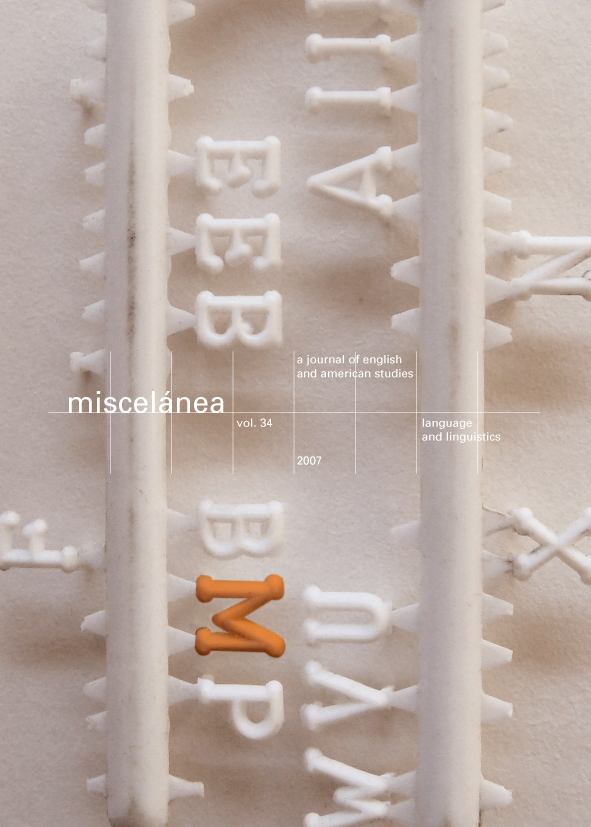Gendered Spaces and Female Resistance: Virginia Woolf’s ‘The Mark on the Wall’
DOI:
https://doi.org/10.26754/ojs_misc/mj.200610112Palabras clave:
Virginia Woolf, Narrativa breve, The Mark on the Wall, Género, Espacio, AnamórfosisResumen
La convicción de Virginia Woolf de que el espacio no es un vacío neutral, sino una red de relaciones culturales, sociales e ideológicas constituye el tema principal del presente ensayo. El género y el espacio se articulan como categorías interdependientes, y, en lo que concierne a la obra de Woolf, requieren ambas de una revisión y reconceptualización. El relato titulado “The Mark on the Wall” de Virginia Woolf, que apareció por primera vez publicado en 1917, expresa tal urgencia, al tiempo que avanza ciertos presupuestos ideológicos que aparecen representados en imágenes recurrentes en obras posteriores. La marca en la pared, a la vez título e imagen central que estructura el discurso narrativo, funciona a modo de obstáculo inquietante y desestabilizador que, por medio de las reflexiones subversivas y dubitativas del narrador anónimo, amenaza con minar el orden y la coherencia operativos en el marco espacial representado por el ámbito doméstico tradicional.
Descargas
Referencias
BACHELARD, Gaston. 1958. The Poetics of Space. Trans. Maria Jolas. Boston: Beacon Press.
BOUMELHA, Penny. 1982. Thomas Hardy and Women: Sexual Ideology and Narrative Form. Madison: The University of Wisconsin Press.
BOWLBY, Rachel. 1997. “‘We’re Getting There’: Woolf, Trains, and the Destination of Feminist Criticism”. In Rachel Bowlby. (ed.). Feminist Destinations and Further Essays on Virginia Woolf. Edinburgh: Edinburgh U.P: 3-15.
CYR, Marc. D. 1996. “A Conflict of Closure in Virginia Woolf’s ‘The Mark on the Wall’”. Studies in Short Fiction 33 (2): 197-205.
DENISOFF, Dennis. 1999. “‘The Forest Beyond the Frame’: Picturing Women’s Desire in Vernon Lee and Virginia Woolf”. In Talia Schaffer and Kathy Alexis Psomiades. (eds.). Women and British Aestheticism. Charlottesville and London: University of Virginia Press: 251-269.
ELLMANN, Maud. 1988. The Poetics of Impersonality: T.S. Eliot and Ezra Pound. Cambridge, Massachusetts: Harvard U.P.
FREUD, Sigmund. 1957. “Beyond the Pleasure Pinciple”. A General Selection from The Works of Sigmund Freud. Ed. John Rickman. New York: Doubleday: 141-168.
FOUCAULT, Michel. 1972-1977. “The Eye of Power”. Power/Knowledge: Selected Interviews and Other Writings 1972-1977. Ed. Colin Gordon. New York: Pantheon Books: 146-165.
—. 1984. “Space, Knowledge, Power”. The Foucault Reader. Ed. Paul Rabinow. New York: Pantheon Books: 239-257.
GILLESPIE, Diane. 1988. The Sisters’ Arts: The Writing and Painting of Virginia Woolf and Vanessa Bell. Syracuse, N.Y.: Syracuse U.P.
HAWKES, Ellen. 1981. “Woolf’s Magical Garden of Women”. In Jane Marcus (ed.). New Feminist Essays on Virginia Woolf. Nebraska: University of Nebraska Press: 31-60.
JAMESON, Fredric. 1988. “Architecture and the Critique of Ideology”. The Ideologies of Theory: Essays 1971-1986. Volume 2: The Syntax of History. London: Routledge. 35-60.
KRISTEVA, Julia. 1986. “Women’s Time”. The Kristeva Reader. Ed. Toril Moi. Oxford: Blackwell: 187-213.
LACAN, Jacques. 1978. The Seminar of Jacques Lacan. Book XI: The Four Fundamental Concepts of Psychoanalysis. New York: Norton.
LEFEBVRE, Henri. 1991. The Production of Space. Trans. Donald Nicholson-Smith. Oxford: Blackwell.
PATER, Walter. 1986. The Renaissance: Studies in Art and Poetry. Oxford: World’s Classics.
RENDELL, Jane, Barbara PENNER and Iain BOORDEN. (eds.). 2003. Gender Space Architecture: An Interdisciplinary Introduction. London: Routledge.
SEELEY, Tracy. 1996. “Virginia Woolf’s Poetics of Space: ‘The Lady in the Looking-Glass: A Reflection’”. Woolf Studies Annual 2: 89-116.
VLASOPOLOS, Anca. 1994. “Staking Claims for No Territory: The Sea as Women’s Place”. In Margaret Higonnet and Joan Templeton. (eds.). Reconfigured Spheres: Feminist Explorations of Literary Space. Amherst: University of Massachusetts Press: 72-88.
VILLEGAS LÓPEZ, Sonia and Beatriz DOMÍNGUEZ GARCÍA. (eds.). 2004. Literature, Gender, Space. Huelva: Servicio de Publicaciones de la Universidad.
WOOLF, Virginia. 1966. The Collected Essays of Virginia Woolf II. Ed. Leonard Woolf London: The Hogarth Press.
—. 1976. Moments of Being: The Unpublished Autobiographical Writings of Virginia Woolf. Ed. Jeanne Schulkind. Brighton: Harvester Wheatsheaf.
—. 1978. The Diary of Virginia Woolf II. Ed. Anne Oliver Bell. Harmondsworth: Penguin.
—. 1985. The Complete Shorter Fiction of Virginia Woolf. Ed. Susan Dick. London: The Hogarth Press.
—. 1992a. A Room of One’s Own/Three Guineas. Ed. Morag Shiach. Oxford: World’s Classics.
—. 1992b. A Woman’s Essays: The Selected Essays of Virginia Woolf I. Ed. Rachel Bowlby. Harmondsworth: Penguin.
—. 1993. The Crowded Dance of Modern Life: The Selected Essays of Virginia Woolf II. Ed. Rachel Bowlby. Harmondsworth: Penguin.
—. 1994. The Essays of Virginia Woolf IV. Ed. Andrew McNeillie. London: The Hogarth Press.
ZIZEK, Slavoj. 1989. The Sublime Object of Ideology. London: Verso.
—. 1991. Looking Awry: An Introduction to Lacan through Popular Culture. Cambridge, Massachusetts: The MIT Press.
—. 1999. “Courtly Love, or Woman as Thing”. The Zizek Reader. Eds. Elizabeth Wright and Edmond Wright. London: Blackwell: 150-73.
Descargas
Publicado
Número
Sección
Licencia

Esta obra está bajo una licencia internacional Creative Commons Atribución-NoComercial 4.0.


